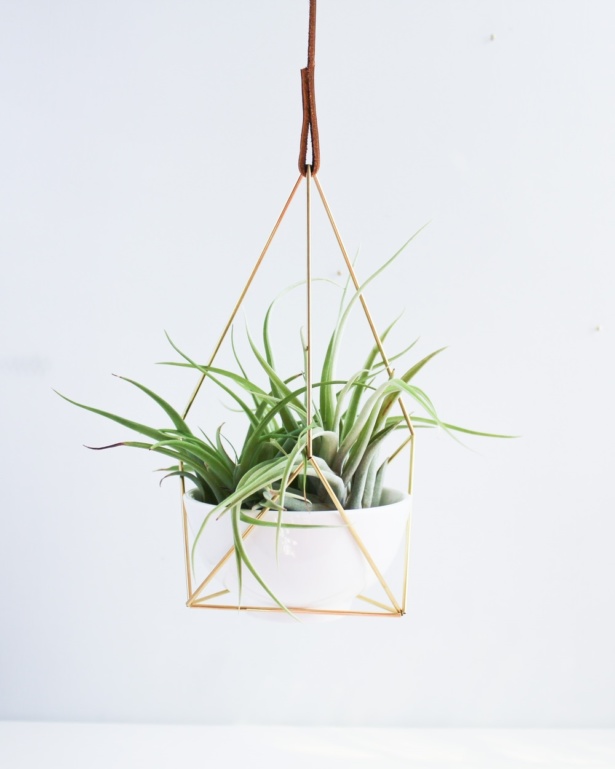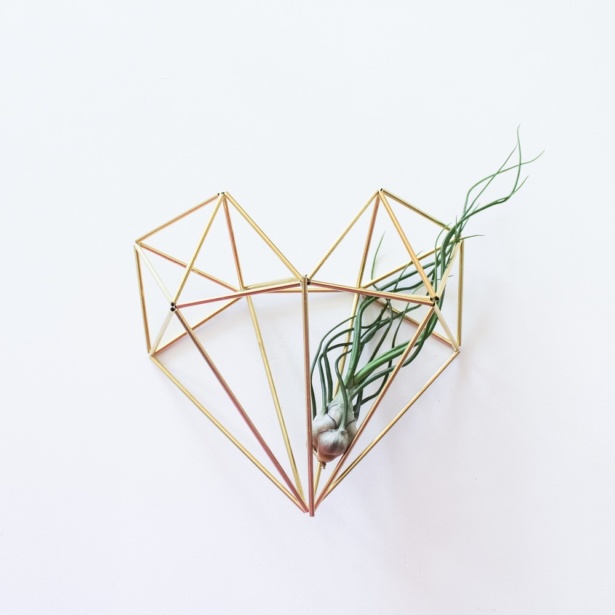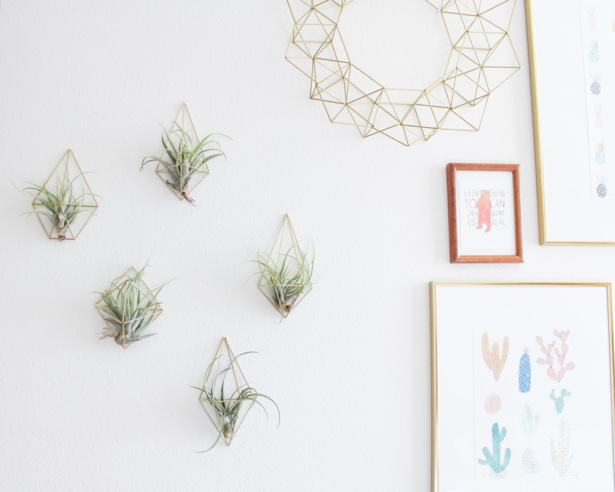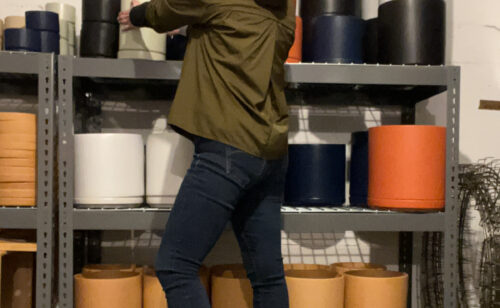
I am pleased to introduce Samantha Leung of Handmade Sam*Made, a successful handmade business, to you. She creates modern himmeli — brass geometric wall sconces and mobiles. Her work is gorgeous, her social media presence is so polished, and her products are totally covetable.
The key thing she did to make her handmade business take off and begin seeing success was to focus her product line on one single thing. I can’t recommend this more for most designers! It may seem like having something to appeal to different shoppers is a good idea, but the struggle goes away when you can target one person with one thing and put your all into it. First I’ll share my interview with Sam, then share my top reasons why you should consider focusing your product line – especially at first.
Hi Sam! What do you create and what makes it so special?
I currently offer a variety of items in my shop. My primary line consists of original brass mobiles that I have designed and make by hand. They are inspired by traditional Finnish mobiles called himmeli.
I also have a certified nursery, and often times pair my himmeli with a number of air plants, as well as offer plant support. While air plants (tillandsia) have been around for quite some time now, there are people discovering them for the first time each and every day. I like to offer my assistance and expertise when it comes to learning about them for the first time, as well as for caring for them.
I am also very excited about my latest addition to my shop. I have started drawing, illustrating and making plant inspired enamel pins. I have been making himmeli for so many years now, that it feels nice and challenging to venture out and to make something completely different.



Is your product entirely handmade? Could you describe who makes your product and how? How has that changed over the life of your business?
When it comes to designing, prototyping and making my brass mobiles — yes, each and every piece is entirely handmade by me. Right down to hand cutting leather for mobiles, and the hand polishing of each and every single strand of brass.
Like with any skill with years of practice, I am so much faster, and better at making himmeli than I was 3 years ago. I actually kept the first himmeli I ever made, as a constant reminder of how far I have come.
Is it important to you that your product stays handmade, and why?
When I started my business my personal belief was that everything should be as handmade and personal as possible. I believe in well made, quality, original handmade items. I like taking the time to package and personalize every order, and always include a handwritten note thanking them for their purchase, primarily because it helps remind them of what they have purchased and they they are receiving something that was made by a real person. The reason why I go to great lengths to add all of these personal touches is to remind myself of something too — that something exists in the world because I exist.
How long have you been in business? What can you pinpoint as a turning point in your business’ popularity and success?
I have been in business since 2013. When I initially started my business, it was a hodgepodge of different things that I made; in hindsight, it was a bit of a mess. I didn’t have a clear vision at all. Not only did I have my himmeli, but I also had amigurumi (small knitted or crocheted stuffed creatures), photography, as well as plushies. Everything was of course handmade and made from original designs, but I wasn’t focused at all. I sold a few photos, amigurumi and then the himmeli started taking off.
The turning point was when I realized that I couldn’t spread myself as thin as I had. I had to focus on one main line, and after I had established myself, only then could I begin branching out.
When I started focusing all of my energy into my himmeli designs, it was like the ideas and designs were being imagined faster than they could be made/photographed and listed. I was making new designs left and right. To this day, I still have a storage area of original designs and prototypes that I love, that I will slowly release one by one.


How much time do you spend on marketing or promotional work?
Between 30 minutes-2 hours a day. It depends on the day, what I want to promote, or if I’m shooting fresh that day.
You have over 20k Instagram followers! How did that happen? Your engagement is pretty good there — do you find that it leads to sales?
I have been on Instagram for almost two years now, and it has definitely been slow and steady when it comes to gaining followers. Which is always the preferred method.
I was at a conference last year, and I spoke to an Instagram influencer. She told me that she had over 50K followers at that point (she has almost 80K now), but it was because her feed is highlighted by Instagram for new users as “people you might want to follow.” And because of that, she gets a lot of followers right off of the bat, but her engagement ratio is shockingly low for her numbers. She credited it to the fact that only a small percentage of personal accounts have users that check in several times a day, and engage with her content. And several accounts will sit empty after the initial sign up process.
As for whether or not my Instagram followers and presence leads to sales, the answer is absolutely! I would say that the majority of my customers and the wholesale shops that carry my pieces around the world have found me through Instagram.
Social media, and Instagram are wonderful things — you can connect with, relate to, inspire, and be inspired by content from individuals thousands of miles away from you. It truly is the exemplification of the globalization of the social marketplace.
How do collaborations and community help your business, and what tips would you offer?
It wasn’t until my second year of my business that I finally saw that there was this enormous, welcoming, loving and supportive community of makers out in the world. At around the same time, I did my first artisan market, I learned about Etsy Teams, Facebook Groups, and started my Instagram account.
Through it all, I have learned so incredibly much, met so many fellow makers that I am happy to call a friend, even if I have yet to meet them in person. Everyone needs a community, and through these venues — in-person shows, social media, and local maker gatherings — I have been able to find and create these wonderful relationships.
I like to say that the start of summer show season is like the first day of school. And that fellow makers that I frequently see at shows are in some ways, a co-worker. We go through similar strifes, wins, complications, and through it all, we learn, build each other up, and look out for each other.
For tips, I would say that if your product allows for it, vend at shows, talk to your neighbors, and join and be as active as possible in an online support group.
What do you like about how you sell your handmade goods? What about your selling process is not ideal for you?
There are three different venues where I sell my items. Online, through Etsy and my personal website; in-person, at artisan markets and pop-ups; and through my 50+ different stockist around the world, all of whom are thoughtfully approved, and act as brand ambassadors.
I enjoy selling directly through my website, because it offers me an opportunity to interact with my customers. Often times when a purchase is made through my site, my customers will either send me photos or tag me in photos of how they style my pieces, and make them their own.
I like to sell in person, because the feedback on all of my designs is instantaneous. The joy and fascination that fills people’s eyes as they take everything in is one of my favorite things, ever.
And finally, I enjoy having so many stockists around the world because these shops are helping to share what I make with an audience that I may otherwise have not had the opportunity to reach.
As for parts of the selling process that are not ideal for me, I would have to say that all of my himmeli are much more beautiful in person than can ever be conveyed online.
How do you see your business growing in the next few years? Do you intentionally keep it small? Would you like to expand? If so, how?
Over the next few years, I hope to be as happy as I am now. I am open to the idea of expanding it, but also want to stay true to my roots, my brand, and my ideals. I take each opportunity as it comes and am simply grateful to be doing and working at something that brings me so much joy.
What advice or encouragement would you give to other handmakers?
I always say three things:
Be as original as you possibly can be.
Start an Instagram account.
If you are waiting for the perfect day to do something, it will never come. Just go, do, it will be messy, you will stumble, but you will also rise, and above all, learn.


Thank you so much, Sam! This is a wonderful perspective on running a successful handmade business.
Why focusing your own product line can be the first step to success
If you’re working on a variety of different product lines of business ideas, and are having a hard time getting traction with any of them, stop! Let’s start small and simple and choose your very best product or idea and make it ALL about that for a while. Here’s why:
- Your product will be better, especially at the start, when you’re spread so thin. If you can put all of your attention into designing and improving ONE product, you have a much better chance of making something stellar than if your attention is divided.
- Single product, single target customer. It will be much easier to hone in on your target customer if you have a single product type, and knowing exactly who your target customer is is vital. If your products are too varied, then you’ve doubled or tripled your work. For instance, if you sell jewelry and bow ties and kids’ clothing, you’re now trying to speak to three different types of customers, and watering down everything that you’re doing. You’ll likely need to promote the three things separately, in different places online, and you’ll run yourself ragged.
- Running your business will be easier. Starting simple makes it more likely you’ll be able to get everything done. Running a business is a lot of work, especially if it’s just you. Trying to juggle all of the responsibilities of running a business with creating and maintaining a variety of product lines is going to be an exercise in frustration. Keep it simple while you’re building an audience, then consider expanding once you can hire some help.
- Marketing and promoting your business will be more effective. It can be easier to promote a single product or product line than a whole shop full of products. For Sam, it’s very easy to talk about her business, because she can just talk about the himmeli. And when blogs or magazines want to feature her, it’s effortless to throw together photos of her himmeli and wow people with them. If bloggers need to explain that you sell himmeli and amigurumi and art photography, not only is that more challenging, but it’s harder for them to write the story for readers who will be into all three.
- Building a brand will be simpler. It’s much easier to gain notoriety as the “modern himmeli designer” than end up being, “the woman who makes the vases and the stuffed toys and takes photographs.”
Sam is now taking this brand she’s built, and treating it to a new name, and a new logo and brand identity design. We’re honored to be her team as she takes this next big step for her business, and I can’t wait to show you how it turns out. Are you at the point where you have a pretty good idea of what you’re doing, and you’re ready to step up your game? Please get in touch with us; we’d be glad to help.
Browse Posts
Newsletter Sign Up
We write a new email each week to help you grow your business.
Related Posts
Let's take your online shop to the next level
The Shopify websites we design have a reputation for substantial improvements to ecommerce conversion rates and online sales. Let's talk!
 Grab my guide to the 10 main ways to grow traffic and optimize to boost sales.
Grab my guide to the 10 main ways to grow traffic and optimize to boost sales.


